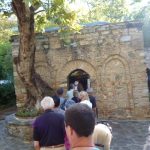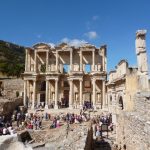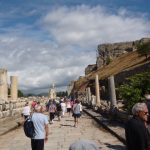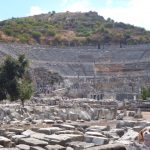Today our port of call is Kusadasi, Turkey. Most people wouldn’t be aware of its significance today, however 2000 years ago it was a different story.
It’s easy to understand when you put the old world in perspective. It’s like this, looking at the globe of the world with a centreline running vertical from the North Pole to the south, put Europe on the left (west) of the centreline and Asia on the right (east), well, the centreline is Turkey.
Now in the old world in trade terms, there are two cities, Ephesus, servicing more of west and Corinth servicing the right.
Kusadasi is the port on the Aegean sea that is the gateway to Ephesus and Corinth. Back in the day Ephesus went right to the sea, however, it is now 3-4 kilometres away from the sea most probably due to the entrance silting up.
So our tour today took us too the home of the Virgin Mary and Ephesus.
The home of the Virgin Mary is not far from Ephesus. Legend goes that John the Apostle took her there for safety as things had deteriorated back in Judea. The early church was active in Ephesus so it seemed a logical place to be. The house was discovered in the 1800’s.
So now it’s on the tourist route for this part of the world, and so the buses come.
Highlights of this part of the tour? The house was small, you could light a couple of candles, and I had to stop Annette from taking some of the candles to add to the array of candles we have at home already. As it was probably a holy candle, it may have burnt longer, I don’t know.
We found the taps where we could fill our bottles with Holy water. Ever wondered how they make Holy Water? One point of view is that they burn the hell out of it, the other is, its a natural spring and it is blessed, I don’t know which story is correct. Lastly the coffee was great at the stop, definitely worth a look while you are here.
Really interesting countryside, olives, figs, pine trees, it kind of reminded me of some areas of the Snowy Mountains around Batlow, NSW, Australia. After this visit, it was then on to Ephesus.
We arrived at Ephesus to lots of bustling crowds trying to get in, however, definitely worth the wait after you go through the turnstiles.
The significance of Ephesus was its Greco Roman culture around the first century. As I previously indicated due to its location, Ephesus was a great commercial city located on the western coast of Asia Minor. It was part of the then “Silk Road”.
From a historical perspective, there was a great deal of pagan worship to Greco Roman Gods. Thousands of pilgrims came to Ephesus yearly to honour the great goddess Artemis, whose temple stood in Ephesus.
Christianity had a foothold in the region due to the Apostle Paul, who I talked about in our Malta visit.
Paul had an early visit around 50AD to Ephesus, however, not long after came back to live for two years to share the story of Christ to people of the city.
In Ephesus, Paul’s preaching affected local magicians, who subsequently burned their books containing magical sorcery’s and tricks. Paul’s preaching caused a reduction in the sale of idols of Artemis to pilgrims visiting the temple of Artemis (Diana), prompting a riot led by Demetrius the silversmith as he was loosing business selling silver idols.
It seems calmer heads prevailed when the city clerk persuaded the mob that they courted Roman reprisals for such unlawful actions.
You can read more about that in the Bible’s New Testament in its history book of the early church called the Acts of the Apostles, Chapter 18:23-21:14.
It was great to hear our tourist guide Certain, (yep, that’s his name) explain the story to us and showed us the actual locations that lined up with historical account where Paul spoke in the public places at Ephesus. Certain, our guide had studied history at University and explained well the legend to the house and all the biblical significance to the early church in Ephesus.
On the archeological front it’s great to see the Turkish government committed to Archeology. Besides the regions of the Middle East that most people know about that are rich in Archeology, Turkey would be up there in terms of Archeological work. While we were there you could see teams of people working on restorations and diggings.
From the pictures below you can see the House of the Virgin Mary, the main streets of Ephesus and shops, the restored front of the Library and the Amphitheatre.
As you can see there were lots of people there when we visited. I thought it gave a great feel for the bustling streets nearly 2000 years ago.
Chris and Annette




